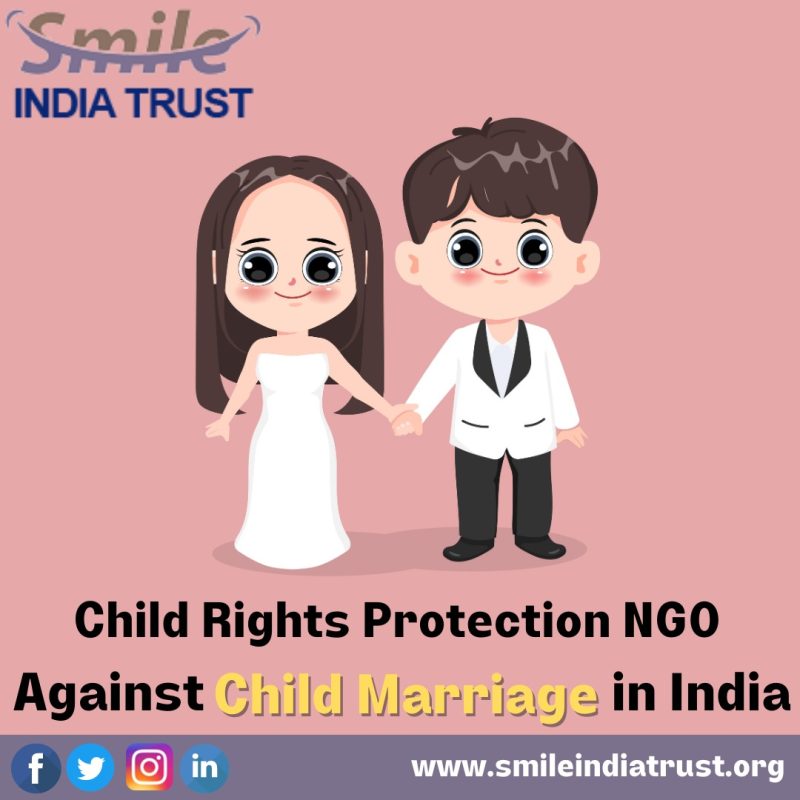Child marriage is a societal practice that is still prevalent in some areas of India. A very young girl child under the age of fifteen marries an adult man in these events. The arrangement of the boy and girl’s future united by both sets of parents constitutes another type of child marriage. The boy and the girl in this type of marriage are not permitted to meet until after the wedding ceremony has been held until they reach marriageable age. Child Rights Protection NGO will discuss all these issues related to child marriage in India.
The frequency of child marriage in Indian society is mostly due to several factors, including poverty, gender disparity, a lack of education, societal standards, concerns about the safety of girls, and sexual control. Girl children in rural settings are more impacted by child marriage than those in urban ones. Yet if one of the partners marries when they are still extremely young, they ask for the marriage declared null and void.
Marriage is a terrific means to bring together two souls who grow enough to handle life’s obstacles. It is a genuine relationship of love and harmony. Child marriage, however, is an immoral approach to joining two individuals that don’t even understand the realities of life. They somehow persuade to be wedded to an unidentified individual even if they have no idea how to deal with good and terrible scenarios.
Child Rights Protection NGO Smile India Trust helps many children who are in trouble situation and rescue them from these hazards. As we see, child marriage is a curse in society that ultimately leads to a decline in economic, social & personal health.
Child Rights Protection NGO on Ill Effect of Child Marriage
The career and future of the children are ruined by child marriage, and even though they are ill-equipped to handle the obligations, they are expected to. A girl child typically endures a lot of hardship. She is expected to live in a home that is fairly difficult for her. Child marriage has several other negative effects, thus the Indian government and other groups should take action to raise awareness of this problem to eradicate it entirely.
The stark evidence of pervasive inequalities and prejudice against women that early marriage, a culturally entrenched societal custom, gives. It is the outcome of the interaction of social and economic factors. Married to a girl as a young child is a common practise in societies. Where social standards and attitudes demonstrate low regard for girls’ human rights.
Girls are thought to have no other role outside of getting married since standards place less emphasis on them than they do for boys. They expect to assist with household duties and chores to get ready for their marriage.
The young age of the marriage has an impact on the girls’ education; child marriage causes problems for the girl. For girls, finishing their education is nearly impossible due to early marriage. There is a significant correlation between girls’ educational achievement and child marriage.
It is very challenging for ladies to continue their education after marrying in the majority of poor nations. The girl’s capacity for education will probably influence whether she marries young or not.
For instance, compared to intellectually excellent girls, girls with lower educational abilities may be less motivated to pursue their studies. Since they anticipate earning less money in the future. Some females are more eager to marry young or their families may be more likely to encourage them.
Statistics on Child Marriage in India
- According to the National Family Health Survey-5 (NFHS-5), 23% of women aged 20 to 24 married before 18.
- In NFHS-3 (2005–06), this percentage was 47%; in NFHS-4 (2015–16), it was 27%; and in the most recent poll, it was 23%.
- The Child Marriage Restriction Act, of 1929 established the first official ban on child marriage in India.
- According to the 1929 Act, it was illegal for boys and girls under the age of 18 to marry.
- The age limit raised in this Act’s 1978 amendment to 18 for girls and 21 for males. Along with the identical minimum age restrictions, the Prohibition of Child Marriage Act of 2006 replaced the 1929 Act.
- With the passage of the Prevention of Child Marriage (Amendment) Bill, 2021, the legal age of consent to women’s marriage would rise to 21. On December 21, 2021
- The Bill submits to the Standing Committee on Education, Women, Children, Youth, and Sports.
Punishment under Child Marriage Act
- If a male over the age of 18 marries a girl under the age of 18, he sentence to two years in a hard labour prison. A fine of up to one lakh rupees, or both.
- A two-year sentence of hard labour in prison, a fine up to one lakh rupees,
- A combination of the two may impose on someone who conducts or assists in child marriage.
- Anyone who encourages or facilitates child marriage penalize with two years in prison, a fine that can reach one lakh rupees, or a combination of the two.
Conclusion
Due to an upsurge in child bride cases in India, the administration passed this law. On the other hand, despite attempts by the government. The populace to help the country develop and prosper, issues like child sexual abuse and child marriage continue to impede our country’s progress.
For any kind of guidance or support, you can write us at [email protected]. Visit our website to understand our work in detail. Click on https://smileindiatrust.org/ to know more about us. Follow us on various social media platforms. We are available on Facebook, Instagram, Twitter

